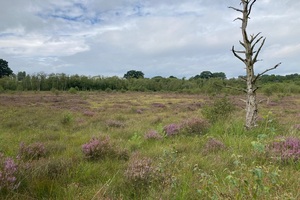Biodiversity increased at Wybunbury Moss National Nature Reserve
Livestock reintroduced and wildflowers increased as Cheshire nature reserve is extended

Natural England hopes the reserve's extension sees nature spill out into the wider area
Image credit: Natural England
Natural England has started work to increase biodiversity on additional land at Wybunbury Moss, one of England’s oldest established national nature reserves, near Crewe, in Cheshire.
This follows an agreement with the Church Commissioners for England to lease two fields of 14.94 acres in an effort to protect the moss and restore the fields to a more natural state.
Work has already begun on the project, which will involve reintroducing livestock-grazing, increasing the diversity of grass and wildflower species, and restoring ancient hedgerows.
Wybunbury Moss, together with its surrounding woodland, reedswamp and flower-rich meadows, covers an area of approximately 16.5 hectares and forms one of England’s most unusual national nature reserves.
The reserve was first designated in 1955, with further land acquisitions added to the area between 1957 and 2009.
It is home to a rich variety of uncommon plants and animals that once would have occurred more widely across the Cheshire Plain.
Wybunbury Moss NNR lies at the centre of the meres and mosses natural area, which includes parts of Cheshire, north Staffordshire and north Shropshire. It is one of a series of peat bogs, or mosses, throughout this area.
Ice movement and erosion in the last Ice Age scraped a series of depressions in the landscape. These wet hollows became vegetated with mosses, which over thousands of years, built up a thick layer of peat. Subsequent subsidence of the rocks underlying the peat-filled basin has left a raft of peat floating on an underground lake, 1 of only 3 known examples in the UK known to have formed in this way.
The peat raft is carpeted in sphagnum moss, along with cotton sedge, cranberry, bog rosemary, white-beaked sedge and the insect-eating sundew. The moss is also important for its invertebrate populations, for which it is one of the most notable sites in Cheshire.
A huge species list includes 2 rare spiders and a leaf beetle - cryptocephalus decemmaculatus - which is not found anywhere else in England.
Paul Shires, senior reserve manager for Natural England in the West Midlands, explained:
Wybunbury Moss is a nationally-important site as it is one of the finest examples in the country of a schwingmoor, or floating bog, and supports an outstanding collection of invertebrates, including many nationally and locally rare species.
This new agreement will help us to protect the moss from high levels of nutrients, which have a serious negative effect on the site’s flora and fauna.
It will also provide an opportunity for nature to spill out on to this new part of the nature reserve.
Zara Gower, farmland portfolio asset manager at landowners the Church Commissioners for England, said:
We are excited to see the arable reversion on this land take place which will have a myriad of benefits, from restoring and extending the biodiversity from the moss, to providing local residents with improved access to nature.
We look forward to our continued work with Natural England here at Wybunbury Moss and other sites as opportunities for partnership arise.
Background Information:
Established in 2006, Natural England is the Government’s independent adviser on the natural environment.
Its work is focused on enhancing England’s wildlife and landscapes and maximising the benefits they bring to the public.